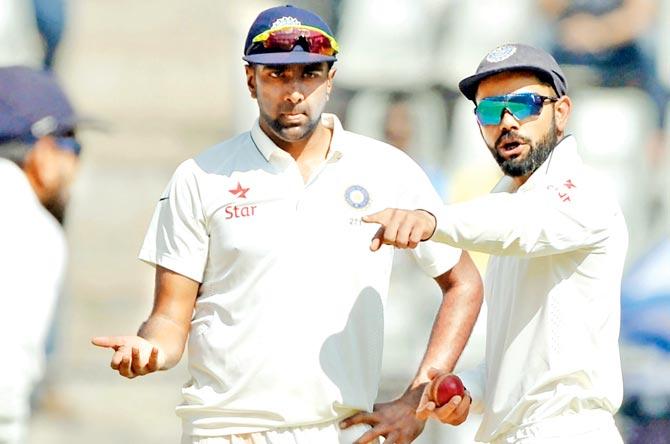Though the debate continues to rage, one major reason why most skippers are batsmen rather than bowlers is because it’s easier for the willow wielders to separate their primary skill from the leadership role

India captain Virat Kohli (right) interacts with off-spinner Ravichandran Ashwin on Day One of the fourth Test against England at the Wankhede Stadium in Mumbai on Thursday. Ashwin has been a terrific performer for India in Test cricket over the last to s

India captain Virat Kohli right interacts with off-spinner Ravichandran Ashwin on Day One of the fourth Test against England at the Wankhede Stadium in Mumbai on Thursday. Ashwin has been a terrific performer for India in Test cricket over the last to seasons. Pic/AFP
Virat Kohli and Steve Smith are both very successful young batsman — captains. It-s an interesting debate, which is the most important, the batting or the captaincy?
ADVERTISEMENT
There-s one major reason why most captains are batsmen rather than bowlers; it-s easier for the willow wielders to separate their primary skill from the leadership role.
A batting captain has little else to concentrate on other than scoring runs. It-s only when a declaration is in the offing — and then only if he-s at the crease — that he has to concern himself with other matters.
When the batsman/captain is in the field, he can concentrate solely on bowling changes and field placements.

Australia captain Steve Smith
Not surprisingly, a few of the captains who have been good bowlers have enjoyed great leadership success; Richie Benaud and Imran Khan are two who readily leap to mind.
Imran believed that to be a good captain you must understand bowling and it-s hard to refute his logic. In the case of both Kohli and Smith they are at least part-time bowlers, which helps them understand and have sympathy for what the trundler is trying to achieve.
This is where a captain can veer off the rails. It-s not the skipper-s job to tell the bowler what he should be doing and where to place his field; that-s not a sign of a strong captain, rather one lacking understanding.
The captain only need ask a bowler how he-s trying to dismiss the batsman and the field placings should then easily fall into place.
Field placement, especially as it relates to a spinner, is something that needs to be sorted out prior to going onto the field. It-s counter-productive for captain and bowler to be having serious debates over where the field should be while the match is in progress.
Understanding bowlers
For a captain who understands bowling — and especially in relation to spinners — the original placing of the field and any resultant changes should come fairly naturally.
If it doesn-t then the bowler and in turn the team, are in trouble. Both Kohli and Smith have been more successful as batsman once they assumed the role of captain. This indicates the selectors have chosen wisely, as it-s crucial to anoint a player who will be buoyed, rather than weighed down by the extra responsibility.
This makes the Indian and Australian method of choosing the captain far better than the one England employed in the days of both amateur and professional players. Then, England often chose the captain [usually an amateur] first, followed by the rest of the team.
Nowadays, it-s commonplace to appoint the captain from the chosen eleven. Both Kohli and Smith have successfully managed a priority of being a batting captain; never forget that making a mountain of runs is a sure way to lead by example.
Kohli has displayed the ability to lift his already high standard in times of need and there was no better example than his second innings century against Australia at the Adelaide Oval. Not only was it an inspirational innings, it firmly declared his hand as a captain who would try to win the game for as long as humanly possible.
Even when his team was going through a horror patch of five successive Test losses, Smith remained the side-s most consistent batsman. His defiant forty eight not out in Hobart when all around him succumbed to the relentless South African attack, was a great example of a captain who refused to wilt.
One area where Kohli has shaded Smith is in the handling of spinners. Under Kohli-s leadership Ravichandran Ashwin has prospered as the attack leader.
Meanwhile, there have been times when Nathan Lyon has struggled to the point where his selection was in doubt until he produced a much-improved effort in Adelaide.
Fascinating contest ahead
It should be a fascinating contest between these two evolving skippers when they clash in early 2017. With both aspects — batting and captaincy — of equal importance, it-ll be the one who provides plenty of runs and inspiration for his bowlers, who will be holding aloft the Border-Gavaskar trophy.
 Subscribe today by clicking the link and stay updated with the latest news!" Click here!
Subscribe today by clicking the link and stay updated with the latest news!" Click here!







